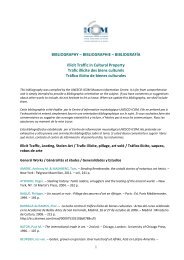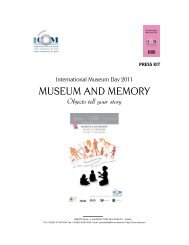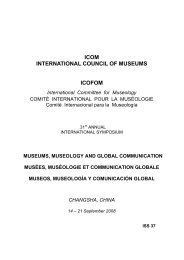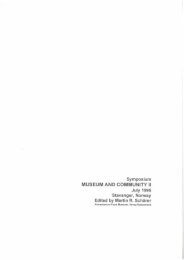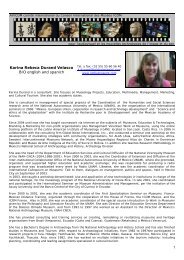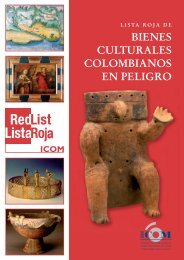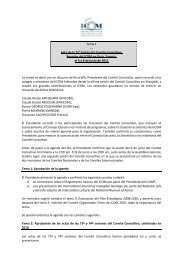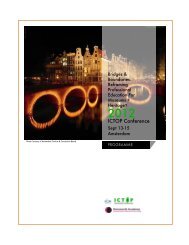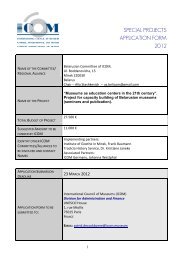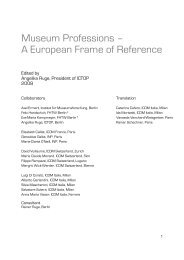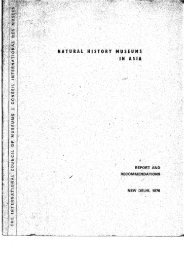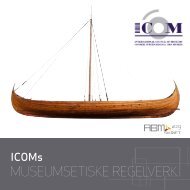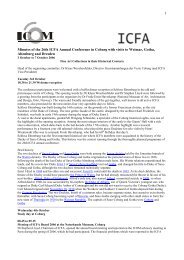Key Concepts of Museology - ICOM
Key Concepts of Museology - ICOM
Key Concepts of Museology - ICOM
You also want an ePaper? Increase the reach of your titles
YUMPU automatically turns print PDFs into web optimized ePapers that Google loves.
28<br />
its assumed materiality as a starting<br />
point. Since this collection is made<br />
<strong>of</strong> material objects – as was the case<br />
very recently for the <strong>ICOM</strong> defi nition<br />
<strong>of</strong> museums – the collection is<br />
identifi ed by the place where is located.<br />
Kryszt<strong>of</strong> Pomian defi nes the<br />
collection as “any group <strong>of</strong> natural<br />
or artifi cial objects that are held temporarily<br />
or permanently outside the<br />
circuit <strong>of</strong> economic activity, subject<br />
to special protection in an enclosed<br />
place designed for this purpose, and<br />
displayed on view” (Pomian, 1987).<br />
Pomian thus defi nes the collection<br />
by its essentially symbolic value, in<br />
so far as the object has lost its usefulness<br />
or its value as an item for<br />
exchange and has become a carrier<br />
<strong>of</strong> meaning (“semiophore” or carrier<br />
<strong>of</strong> signifi cance). (see Object).<br />
3. The recent development <strong>of</strong><br />
museums – in particular the recognition<br />
<strong>of</strong> intangible heritage – has<br />
emphasised the more general nature<br />
<strong>of</strong> collections while also raising new<br />
challenges. Intangible collections (traditional<br />
knowledge, rituals and myths<br />
in ethnology, ephemeral gestures and<br />
performances in contemporary art)<br />
have led to the development <strong>of</strong> new<br />
systems for acquisition. The material<br />
composition <strong>of</strong> objects alone sometimes<br />
becomes secondary, and the<br />
documentation <strong>of</strong> the collecting process<br />
– which has always been important<br />
in archaeology and ethnology<br />
– now becomes the most important<br />
information. This information is not<br />
only part <strong>of</strong> research, but also part<br />
<strong>of</strong> communicating to the public.<br />
Museum collections have always<br />
appeared relevant provided that they<br />
are defi ned in relation to the accompanying<br />
documentation, and also<br />
by the work that results from them.<br />
This evolution has led to a much<br />
wider meaning <strong>of</strong> the collection as<br />
a gathering <strong>of</strong> objects, each preserving<br />
its individuality, and assembled<br />
intentionally according to a specifi c<br />
logic. This latter meaning, the most<br />
open, includes toothpick collections<br />
accumulated as well as traditional<br />
museum collections, but also collections<br />
<strong>of</strong> oral history, memories or<br />
scientifi c experiments.<br />
DERIVATIVES: COLLECT, COLLECTION, COLLECTOR,<br />
COLLECTION MANAGEMENT.<br />
CORRELATED: ACQUISITION, CATALOGUE,<br />
CATALOGUING, CONSERVATION, DEACCESSION,<br />
DOCUMENTATION, EXHIBIT, EXHIBITION, PRESERVATION,<br />
RESEARCH, RESTORATION, RETURN, RESTITUTION, STUDY.<br />
COMMUNICATION<br />
n. – Equivalent in French: communication;<br />
Spanish: comunicación; German: Kommunikation;<br />
Italian: communicazione, Portuguese:<br />
communicaçāo.<br />
Communication (C) is the action<br />
<strong>of</strong> conveying information between<br />
one or several emitters (E) and one<br />
or several receivers (R) through a<br />
channel (the ECR model, Lasswell<br />
1948). The concept is so general that<br />
it is not limited to human processes<br />
<strong>of</strong> bearing information <strong>of</strong> a semantic<br />
nature, but is also encountered in<br />
relation to machines and to animals<br />
or social life (Wiener 1949). The



